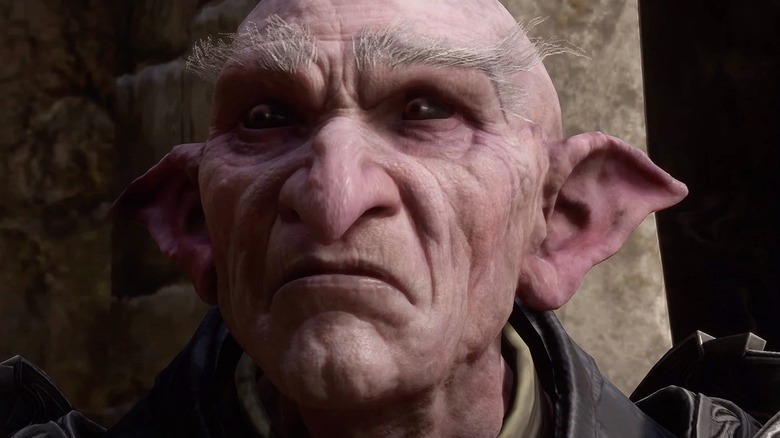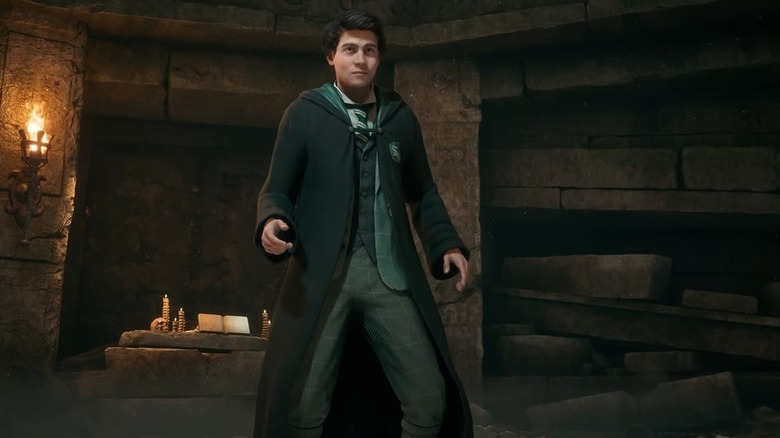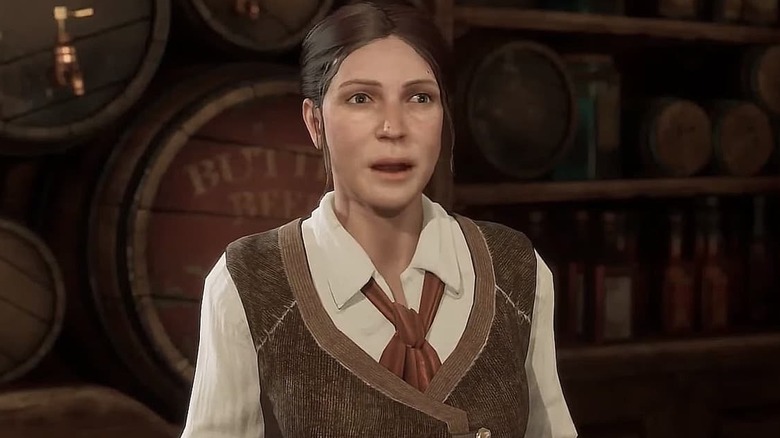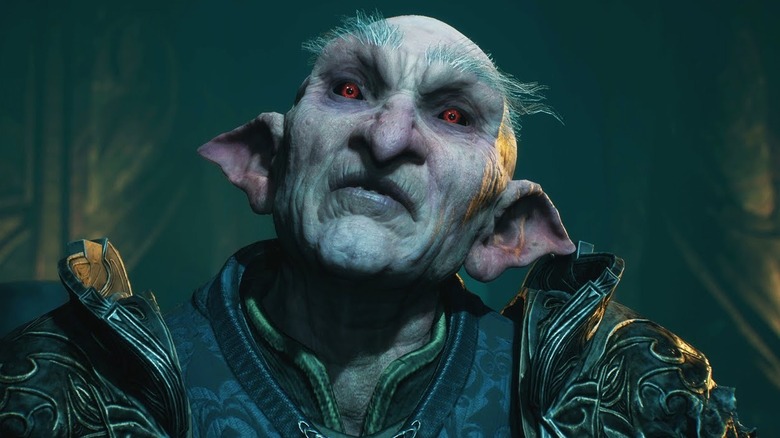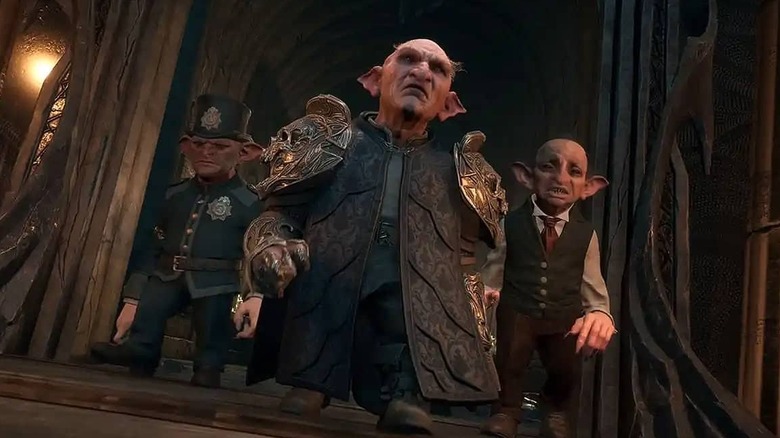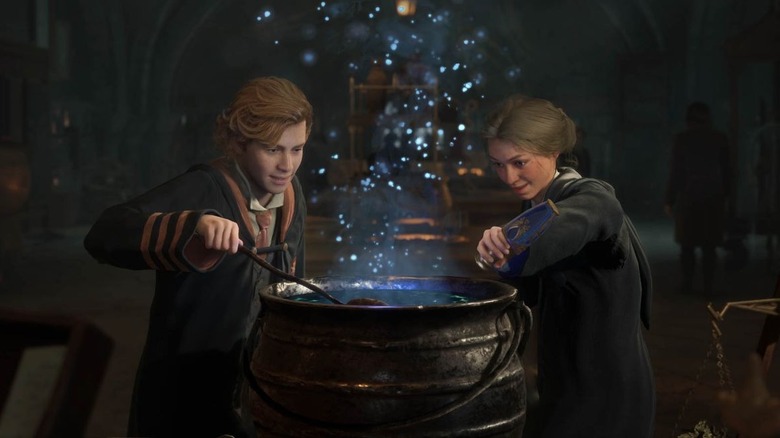Things Only Adults Notice In Hogwarts Legacy
"Hogwarts Legacy" has been a smash success, in spite of mixed reviews and all of the controversy that has followed it through development and release. Although there have been troubling issues behind the scenes of the game, fans of the Wizarding World have largely been happy to attend a virtual version of their favorite magical school.
The game's Teen rating has not stopped younger fans of the series from taking part in the fun, but there are several aspects of the game that may only be apparent to the older gamers in the audience. Much like the series of books and films that inspired it, "Hogwarts Legacy" is packed to the brim with darker moments and themes that kids just wouldn't pick up on. From goblin's rights to the slippery slope of the dark arts, here are things only adults might notice in "Hogwarts Legacy."
Beware of spoilers ahead for the plot of "Hogwarts Legacy."
Sebastian isn't exactly a villain -- at first
In "Hogwarts Legacy," players can befriend a Slytherin student named Sebastian Sallow, who can in turn teach the player a few dark spells over the course of several side missions. Some of these spells are in fact Unforgivable Curses, dangerous magical charms that have been outlawed by civilized wizards. With such heavy magic at his disposal — including the deadly Avada Kedavra spell — one might think that Sebastian Sallow is pretty much a villain, right? Well, not exactly.
Yes, Sebastian ends up going down the wrong path, to the point where he even kills his own uncle in a fit of rage. However, his quest started off with pure intentions. Throughout the game, Sebastian only seeks to cure his sister of the ailment that is slowly killing her. This leads Sebastian to do things he might not have ever done otherwise, especially as he grows more desperate and his sister's condition worsens.
Younger players may see "Hogwarts Legacy" as a black and white tale of good wizards vs. bad ones, and much of it does play out that way, right up until the game's ending. However, much like Severus Snape in the books, Sebastian truly believes he's doing the right thing, and even the horrible moves he makes come from a place of love. Sebastian may be irredeemable by the end of the story, but he definitely didn't start things off with wicked intentions.
The problem with Sirona Ryan's name
"Harry Potter" creator and author J.K. Rowling has stayed in the news pretty consistently over the last few years, and for reasons that have upset a large section of the fanbase. The author's comments about the transgender community have cast a long shadow over the franchise, to the point where some fans have outright boycotted the game. That's why it came as such a surprise to learn that "Hogwarts Legacy" actually features a transgender character in the form of Sirona Ryan, the owner of the Three Broomsticks pub.
Although Sirona doesn't figure heavily into the plot of the game, the inclusion of a trans woman in the Wizarding World has been seen as a win by many people in the gaming community and "Harry Potter" fandom. However, others have pointed out that Sirona Ryan may not be the most shining example of representation, and a lot of it has to do with her name. A number of critical eyes, including "Queer As Folk" showrunner Jaclyn Moore, have pointed out that Sirona Ryan's name begins with "Sir," and that her last name is traditionally a male name.
Sirona Ryan is such an insane thing to name the first trans Harry Potter character. They might as well have called her Misterima David or Boybitsa Jerry.
— Jaclyn Moore (@JaclynPMoore) February 6, 2023
This unfortunate bit of wordplay — intentional or otherwise — probably goes right over the heads of younger players.
The game avoids some of the antisemitic complaints against goblins
Aside from fan concerns over Rowling's comments about transgender rights, another common argument against the "Harry Potter" series is its depiction of goblins. Some readers and viewers have criticized Rowling's decision to depict goblins in the world of "Harry Potter" as greedy, scheming bankers, arguing that the author leaned on antisemitic stereotypes to describe the creatures. The film adaptations didn't revise the portrayal, and even doubled down on the description by adding in long noses.
Comedian and longtime "Daily Show" host Jon Stewart famously commented on the goblins in "Harry Potter" on his podcast, arguing that he couldn't believe that Rowling chose, in a world full of fantastic creatures and magical feats, to feature what appear to be caricatures of Jewish people running a secretive, tightly guarded bank. Stewart joked that Rowling might have looked at a caricature from antisemitic propaganda and developed the characters from there. The scene from the film doesn't do Rowling's defenders any justice, as it presents goblins with even bigger noses, even pointier teeth, and an even bigger obsession with money. The comparison was so prevalent, that even the irreverent Pete Davidson had to comment on it on "SNL."
Luckily, "Hogwarts Legacy" takes a slightly different route with these highly intelligent beings, adjusting them into a portrayal that is much more socially acceptable — and less stereotypical. While the game doesn't drastically change the physical appearance of the goblins, it does do something more nuanced with their storyline, giving them a chance to be more than money-hungry banktellers. What it doesn't do, however, is make wizards less mean to them...
The Goblin Rebellion wasn't inherently wrong
Okay, okay. We're not going to say that Ranrok, the game's main goblin antagonist, is totally justified in turning himself into a dragon and attacking innocent people in the game's finale. People definitely shouldn't breathe fire on other people. But the Goblin Rebellion that plays out in "Hogwarts Legacy" is rooted in very real prejudices — and it makes sense why the goblins eventually decided to rise up.
In the Wizarding World — even in the modern day stories populated by Harry and his friends — goblins are seen as lesser forms of life. Even though they have a high level of intelligence (and they're literally math geniuses), goblins are subject to heavy scrutiny and regulation. They're not allowed to carry wands and are generally treated as untrustworthy among wizard society. Most upsetting of all, wizards seem to believe that goblins are fine with being treated as second-class citizens. The treatment of goblins (and elves) is often seen as one of the most questionable aspects of the "Harry Potter" franchise.
When the Goblin Rebellion begins, it's ignited by a desire for goblins to be free from prejudice and given the same rights as the humans in the Wizarding World. The battles eventually escalate and become much more brutal and bloody, but again, it's hard to argue against the basic desire to be treated fairly.
It must suck to go to school with the protagonist
The protagonist of "Hogwarts Legacy" joins the titular school at the age of 15, as opposed to the standard enrollment age of 11. Beginning classes as a Fifth Year student doesn't really seem to be much of an issue, though. Not only does the main character manage to catch up pretty quickly, but they are a bit of a prodigy, picking up advanced skills and executing them without much trouble. Much like Harry Potter himself, the protagonist is a bit of a Mary Sue who is instantly great at pretty much everything. Point blank: It must be really frustrating to be this kid's classmates. Imagine studying for four years only to be outmatched in every way by someone who just picked up their first wand.
Of course, there are reasons for this from a development standpoint. The developers told Gamereactor that they felt uncomfortable sending an 11-year-old into tense combat scenarios (not that this ever stopped the franchise before), so the protagonist was aged up a bit. This also allowed the character to properly engage with the more mature themes in the story.
Older players are a bit more likely to notice the seams when it comes to the world-building in "Hogwarts Legacy," even if these concessions were made out of necessity. It's hard not to see the overachieving main character through the eyes of fellow students, who have put so much work in already.

